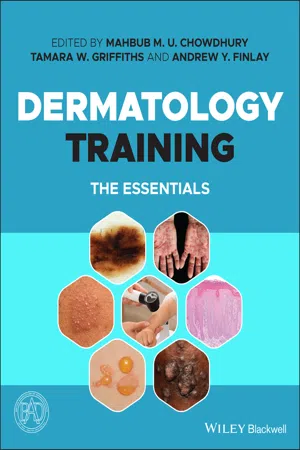
Dermatology Training
The Essentials
- English
- ePUB (mobile friendly)
- Available on iOS & Android
Dermatology Training
The Essentials
About this book
The fundamentals of professional development, clinical practice, general dermatology, therapeutics and procedural dermatology, and specialist areas of dermatology relevant to all UK and international trainees and healthcare professionals are addressed in 29 reader-friendly chapters.
Throughout this highly practical textbook, the expert authors provide tips and advice for handling common clinical situations, developing leadership skills, getting into research and gaining surgical experience, as well as key pearls and pitfalls. The book contains over 70 Specialty Certificate Exam (SCE) questions to assist in exam preparation, and includes contributions from current trainees that offer real insights into day-to-day dermatology training. A must-have for all those involved in the dermatology training process, including educational supervisors, this textbook:
- Provides detailed descriptions of the key themes that trainees in dermatology need to understand
- Features over 500 clinical images, tables and figures including disease presentations in various skin types, and highlights relevant issues relating to skin diversity
- Aligns with the new Capabilities in Practice (CiPs) assessment tool, which evaluates the trainee's ability to deliver and perform in the workplace
Dermatology Training: The Essentials is highly recommended reading for all trainees in dermatology, doctors taking the Certificate for Eligibility for Specialist Registration (CESR) route to accreditation in dermatology, general practitioners training for an Extended Role (GPwER), and junior doctors and medical students considering a career in dermatology.
Frequently asked questions
- Essential is ideal for learners and professionals who enjoy exploring a wide range of subjects. Access the Essential Library with 800,000+ trusted titles and best-sellers across business, personal growth, and the humanities. Includes unlimited reading time and Standard Read Aloud voice.
- Complete: Perfect for advanced learners and researchers needing full, unrestricted access. Unlock 1.4M+ books across hundreds of subjects, including academic and specialized titles. The Complete Plan also includes advanced features like Premium Read Aloud and Research Assistant.
Please note we cannot support devices running on iOS 13 and Android 7 or earlier. Learn more about using the app.
Information
Section 1
Developing professionalism
1
Think critically, research and publish
Introduction
Why undertake research?
When should I do research?
What type of research should I conduct?
Clinical audit
Table of contents
- Cover
- Table of Contents
- Title Page
- Copyright Page
- Preface
- About the Editors
- Foreword
- Authors
- Acknowledgements
- Abbreviations
- About the Companion Website
- Section 1: Developing professionalism
- Section 2: Fundamentals of clinical practice
- Section 3: General dermatology
- Section 4: Therapeutics and procedural dermatology
- Section 5: Subspecialty dermatology
- Key resources and websites
- Specialty Certificate Exam (SCE): questions
- Specialty Certificate Exam (SCE): answers
- Dermatology training and Capabilities in Practice
- Index
- End User License Agreement